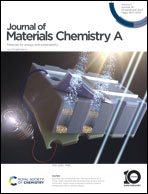Elevated photooxidation of CH4 to C1 liquid products over an anatase/rutile TiO2 biphase junction†
Abstract
Methane (CH4) is plentiful in the Earth's crust and constitutes one-fifth of the worlds principal energy sources. The solar driven direct conversion of CH4 to produce value-added C1 liquid products is a double-edged sword used to mitigate the global energy and environmental crisis. However, current CH4 photocatalytic conversion suffers from low carrier separation efficiency. Herein, an anatase/rutile (A/R) TiO2 biphase junction was prepared and used for CH4 conversion. The highest total C1 yield of 9.94 mmol g−1 h−1 was obtained under optimized experimental conditions. The formation processes of the products were studied carefully and monitored using ESR, DFT calculations and in situ FTIR. The largely improved performance of the P25-800/2 catalyst was related to the A/R heterojunction and was studied via energy band structure analysis and spectral/electrochemical measurements. The results indicated that the formed A/R heterojunction not only improved carrier separation, but also largely reduced the reaction energy of CH4 → CH3via enhanced CH4 polarization. These two factors worked together and resulted in a substantially elevated C1 product yield.



 Please wait while we load your content...
Please wait while we load your content...